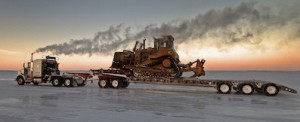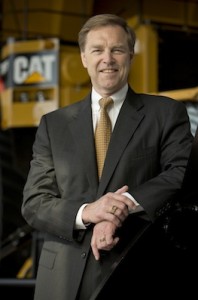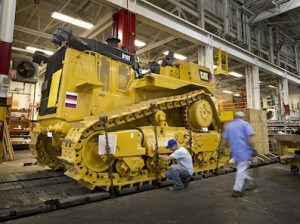Caterpillar moves the earth for better distribution
The volumes and logistics capabilities of the world’s largest maker of earth-moving machinery are intertwined with global growth and government investment in its US-base
Moving high-and-heavy equipment, such as construction machinery, is a tricky and costly logistics task. Many products are outsized, requiring dedicated facilities and special permits to travel on roads. While the volume of this machinery might be lower than for mass-produced passenger cars, it is an industry that is equally, if not more, global than automotive. Leading equipment producers have a large share of their markets flung across China, the Middle East, Australia, Brazil as well as North America and Europe, so a highly coordinated supply chain strategy is essential.
Such is the case for the world’s largest manufacturer of earth moving equipment, Caterpillar, based in Peoria, Illinois. For its North American and US operations, which include a sweeping dealership network and many global export destinations, velocity and visibility are among the most important considerations.
The company has made a number of important systems investments and process changes to its outbound logistics, which are already contributing to double-digit improvements in transport efficiency. However, in the medium term, some of the company’s top executives are concerned that a lack of investment and funding for infrastructure in the company’s home US market could be a drag on both revenue and delivery performance.
Caterpillar’s revenue is intertwined with global business cycles, which adds even more complexity to its supply chain. The OEM’s revenue in 2012 was $65.87 billion, an increase of nearly 9.5% compared to 2011, reflecting growing demand for infrastructure and mining in North America and emerging markets like China. However, Caterpillar’s global revenues have declined so far in 2013 in parts as a result of weakness in mining demand and other commodities in China and Australia, for example. The company now predicts revenue in the $56-$58 billion range.
"[Caterpillar has] spent considerable time integrating US-Mexico border operations...[it] uses a build-to-ship model that enables us to pre-book transportation even before we build the machine or engine" - Tom France, Caterpillar
A global approach out of North America
In the US, Caterpillar has production facilities across 11 states, with concentrations in the midwest and the south. The company’s US plants serve the rest of North America as well as global markets, and they build products ranging from construction equipment to earth moving machines, forestry vehicles, turbines, generator sets and engines. Caterpillar also produces a range of work tools that attach to other machines, including buckets, shovels, augers, rippers, forks, backhoes and brush cutters. Such components add further complexity to shipping finished products, as the material adds to the outsized shapes and weights of much of this equipment.
Caterpillar also imports equipment from global locations to serve its 57 dealerships in North America. It outsources all of its transport and works directly with its carriers, according to global transportation director Tom France. Unlike many passenger carmakers, he says, Caterpillar puts more logistics responsibility into the hands of its dealerships, managing the transport for around 20% of its shipments to US dealers, while 80% is handled by dealers directly.
While US transport operations are outsourced, Caterpillar operates a centralised global distribution network that takes a coordinated control over international product movements. For all of its American exports, it manages the outbound logistics by working directly with trucking companies, rail and ocean carriers. This central focus on exports compared to domestic logistics is understandable given the scale of operations. From its headquarters in Illinois, Caterpillar manages finished product shipments to more than 150 countries worldwide and uses more than 700 ports.

Caterpillar has an advanced order and manufacturing process, and dealerships have the option of selecting built-to-order products directly from its plants. Caterpillar also operates product distribution centres (PDCs), from which it offers pre-built machines that dealerships may order and take delivery of within a short timeframe. Caterpillar-operated PDCs are located in Tacoma, Washington; Galveston, Texas; Baltimore, Maryland and Manzanillo, Panama.
The manufacturer employs trade lane managers who are dedicated to high volume lanes and who work with its product managers and dealerships to solve strategic issues. As well as overseeing its transport management, Caterpillar’s broader team provides a number of integrated logistics services that include management of its PDCs, inventory management and delivery management of kanban parts, network design, route optimisation, and negotiation with service providers, and even in-plant logistics at some facilities.
Building a network for exports
Caterpillar exports about 50% of the machines and engines that it manufactures in the United States, says Tom France. Of Caterpillar’s total US machine production, it moves about 10% to Europe, 5% to South America, 5% to Asia, and 30% to Canada and Mexico.
Caterpillar currently ships around 98% of its North American sales by truck and 2% by rail. It moves equipment exclusively by truck to Mexico, while about 15% of the company’s Canadian-bound products move by rail. France predicts that as Caterpillar continues to scale its volume in North America and the economy improves, it might increase the percentage of rail relative to truck transport that it uses.

About 60% of US-built Caterpillar exports head to Canada or Mexico, with the rest going overseas. For overseas volume, the company uses an intermodal combination of ocean containers and drayage. It also sends a large amount of equipment using ro-ro carriers, and Caterpillar manages the transport from its plants to the ports as well as the ocean carriage.
The company’s largest growth markets tend to be in places that demand equipment for mining, oil and gas development and infrastructure building. Although its destinations may vary from year to year, strong export markets for Caterpillar currently include Mongolia, Africa, Russia, Australia, Brazil, Chile and Australia.
Caterpillar’s highest volume of imports come from Japan and Europe. “In most cases, we arrange transportation to the port of entry in North America and the dealership manages the inland transportation,” explains France.
One of Caterpillar’s most important trade lanes is between the US and Mexico for over-the-road shipments. “We have spent considerable time integrating our US-Mexico border operations from a cost perspective and a velocity perspective,” says France. “This involves using a build-to-ship model that enables us to pre-book transportation capacity even before we build the machine or engine. We schedule the carrier to arrive on the same day that we produce the product.”
Another aspect of its logistics network integration is that Caterpillar uses visibility tools that show all of its pick-up and delivery locations and hand-off dates. These tools provide EDI information to carriers and dealerships so that they know when the products will be available. Its tracking technology uses a visibility tool from software provider GT Nexus, which ties Caterpillar’s tracking milestones to its logistics partners and provides visibility at the product level.
France says that Caterpillar also uses control towers to monitor its shipments and, if necessary, divert them to faster transport modes. “Cross-border integration also involves managing our inventory so that we may scale our shipping movements. This enables us to take advantage of available transportation capacity such as unit trains, so that we may reduce our costs and increase our velocity,” says France.
Although Caterpillar does not have the kind of volume that would allow it to maximise return loads from the north and south – in the way some carmakers can – France says that it does ship truck bodies from Mexico with return loads of its finished products from American factories to Mexico.

The company is in the process of implementing a full-load planning and execution process for all of its northbound and southbound US-Mexico shipments. “We hope to have our load planning and execution process fully ramped in by the end of 2014,” says France.
He also points to several advanced processes that are built into Caterpillar’s IT systems. The manufacturer uses an integrated tool to procure, plan and execute its transport loads for domestic and international shipments. Caterpillar has also been adding incremental functionality to enhance the tracking and planning of its finished machine movements. The goals are to reduce dwell time and manage carrier performance more effectively, says France.
Along with transport management, Caterpillar has a web-enabled proprietary system for global tracking of inventory, from products in stock to built-to-order equipment in the factory or those already in transit.
Picking up speed and efficiency
For the North American market and exports, one of Caterpillar’s enduring challenges is to maintain velocity when transporting to remote areas with limited volumes. These locations vary from year to year, depending on the demand level, says France. “For us, the issue is not about trading lower costs for higher velocity or vice-versa. We need both in order to meet our customers’ demands,” he says.
Caterpillar’s focus on increasing its shipment velocity is about eliminating dwell time as it transfers its products between transport modes. “This includes any time that we use a transhipment hub – whether it is a rail switching centre or an ocean transhipment point,” says France. “Caterpillar may have more than $1 billion worth of finished products in-transit on any given day, so it is critical that we reduce dwell time as well as variability in our shipping process.”
One way that Caterpillar may reduce its logistics variability is through improved visibility for certain parts of its outbound supply chain. “Our focus now is on improving visibility within a transhipment hub or for domestic truck shipments,” says France. “We already have excellent visibility for international shipments across all modes of transportation.”
Another area on which Caterpillar is working is to increase its load factor by reviewing its designs for transport packaging and protection. Packaging improvements are enabling more products to fit on a rail wagon or a step-deck trailer, as well as in containers for ocean shipping. France reports that as a result of all of these logistics developments, Caterpillar has been able to increase its overall logistics efficiency in the range of 10-15% on large volume lanes.
As Caterpillar makes internal changes to improve its product distribution efficiency, it still faces a number of external challenges, in particular the need for adequate infrastructure and appropriate regulations and procedures. France points out that the US is currently lagging in both areas. On the regulatory side, he complains about the permit system, particularly for moving across state borders. “The state-by-state permitting system is non-uniform, complex, and can add multiple transit days in delays in order for us to obtain the required permits.”
Infrastructure is a major issue for the US as far as Caterpillar is concerned, with many roads and bridges unsafe to move across with heavy loads, says France.
“Furthermore, our port infrastructure is out of date in that most east coast and Gulf coast ports cannot handle the larger deep draft vessels that are joining the fleets in 2015 when the Panama Canal expansion can accommodate them,” he adds.
Moreover, France admits that the process of slow steaming – the reduction of a vessel’s speed so as to reduce fuel consumption – has added as much as five days to some of Caterpillar’s transit legs for international shipments. Looking ahead, France predicts that capacity shortages of rail wagons and heavy-haul equipment will become an issue again in the US as the economy expands.
Caterpillar is particularly concerned about infrastructure spending at a government level. The firm pays close attention to the Obama administration’s plans in this area. The country’s most recent measure is the federal Moving Ahead for Progress in the 21st Century Act (MAP-21), which governs federal surface transport spending. The two-year, $105 billion authorisation bill became law in July 2012.
"The deterioration of funding efficiency is due to less fuel consumption, which generates less tax revenue. [The US] has lost the ability to fund its highway development adequately" - Stuart Levenik, Caterpillar
With the US government stuck in political gridlock, passing investment bills for longer periods has been a challenge. One of the proponents of longer-term funding for infrastructure development is Stuart Levenick, group president of Caterpillar, who has administrative responsibility for customer and dealer support, including Europe, the Middle East and Africa, the Americas and Asia Pacific distribution divisions, remanufacturing and components, customer services support, parts distribution and logistics. Levenick says the country’s transport funding model is broken.
“Congress has no sustainable model. One year from now, we will be in the same position,” he says.
Levenick says highway infrastructure is the foundation of the US economy and he believes that policymakers should focus on the deficiencies in the country’s road network, intermodal rail system and ports. He says the US is losing valuable business as a result of neglecting infrastructure, including to Canada. Levenick notes that 40% of Caterpillar’s imports and exports in North America use the port of Montreal and its railway connection, which is two to three days faster than using the port of Norfolk, Virginia. Similarly, on the west coast, the port of Prince Rupert, British Columbia is two days faster than the port of Long Beach because of congestion.
Electric shock to funding

Levenick says the problem is that surface transport programs receive funding through the Federal Highway Trust Fund, which was sourced from gasoline taxes. “The deterioration of funding efficiency is due to less fuel consumption, which generates less tax revenue. We have lost the ability to fund our highway development adequately,” says Levenick.
Last autumn, the US Congress extended the General Funds Appropriation for highway development by two years, which the general taxpayer is absorbing. “In the long term, the best way to fund highway development is with a highway user fee, but no one wants a gasoline tax. Pure gasoline consumption is no longer in alignment with highway usage due to electric cars and hybrid cars,” says Levenick.
The implications of failing to properly fund US infrastructure would have negative consequences for Caterpillar’s sales, given its construction and energy machinery), but clearly the company also sees risks to its wider supply chain. Highway and port infrastructure is vital to the company because of its highly global machine trade, as well as its increasing flows between the US and Mexico. As Caterpillar invests in visibility and planning systems to help avoid logistics bottlenecks, it is hoping that the US government will take measures to do the same.






